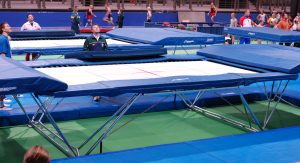More Articles...
Trampolines are no longer a new trend. They’re now enjoyed all around the globe and have even become a competitive sporting event in the Olympics.
A trampoline is a fantastic way to improve the air awareness of all aerial athletes. It’s no wonder that trampolines have made their way into gymnastics gyms, swimming pools and facilities for training skiers. The most critical part of a trampoline for performance is the bed. Right after that comes the springs. Gym owners should be knowledgeable about springs to choose the right equipment for their trampoline & gymnastic facilities.
This guide takes a deep dive into what gym owners need to know about trampoline springs.

What Types of Trampolines are Available?
The majority of trampolines can be grouped into two types, competitive and recreational. Recreational trampolines are primarily used by families for entertainment, physical activity and backyard fun.
Competitive trampolines have more bounce than recreational trampolines. Competitive springs are purpose designed to stretch much further than the springs used in recreational trampolines. Additionally, most competitive springs are designed to give a smooth and even bounce to the trampoline.
Important tip: Gym owners need to not only choose spring-based trampolines, but they also need to consider the strength of the springs and the tension offered by them. The quality of a trampoline’s jumping surface (bed) is yet another important factor.
What Trampoline Springs are Made of?
All trampoline springs are made of steel. This is coated to prevent rust by a variety of methods. The most common being use of pre-galvanized standard spring wire or Zinc plating.
Top quality Springs are also made from specialized music wire. Not many companies’ manufacturer springs with music wire. Music wire is very strong and durable. It allows a spring of similar weight to last a long time. Galvanized steel springs use cheaper wire so springs lose tension quicker, requiring frequent replacement or a soggy irregular bounce.
Competition Trampoline springs are stretched to about 15 inches before anyone steps on the bed providing about 39lbs of tension. They should be able to withstand an additional stretch of at least an additional 15 inches without any tension loss.
Do You Need to Replace Trampoline Springs?
The trampoline springs are a critical component, so it’s important to know when they should be replaced for maximum safety and performance. If you’re a gym owner, look into how much the trampolines in your gym are used as well as how often larger and higher bouncing athletes are stressing your springs.
Two good indicators that some of your springs need replacing are; 1) the bed is getting very soft (might be bed stretch) and 2) the lines on the trampoline bed curve. If the bed has a curve and the frame is straight, try to locate the pocket of worn springs. Replace them or distribute them evenly around the frame so the bed curve is gone. Otherwise the trampoline will not throw straight up!
All springs eventually break due to wire fatigue unless the users do not stretch them far enough to create fatigue cycles. If this is happening in less than 3 years, you purchased the wrong brand. Once spring breakage is getting common you can extend their useful life somewhat by rotating springs from high to lower wear areas. However, most likely all of your springs are old and have fatigue cracks going partly through the wire. If so it is best to get a new set. Failing to replace trampoline springs could lead to injuries and legal consequences.
How Can I Prolong the Lifespan of Trampoline Springs?
Make sure you have frame pads which cover the springs completely and are held up by pad lifters. One athlete on the bed at a time. Encourage particularly the larger and more powerful athletes to stop before they land near the edges. Buy good springs.
Conclusion
When it’s time to replace the trampoline springs on your trampoline, you’ll need the hook-to-hook measurement of your previous spring to help you buy new springs. We highly recommend choosing new springs instead of used springs. If you have questions or want a better understanding of how trampoline springs impact the performance of a trampoline, schedule a call with Rebound’s product sales representatives.

